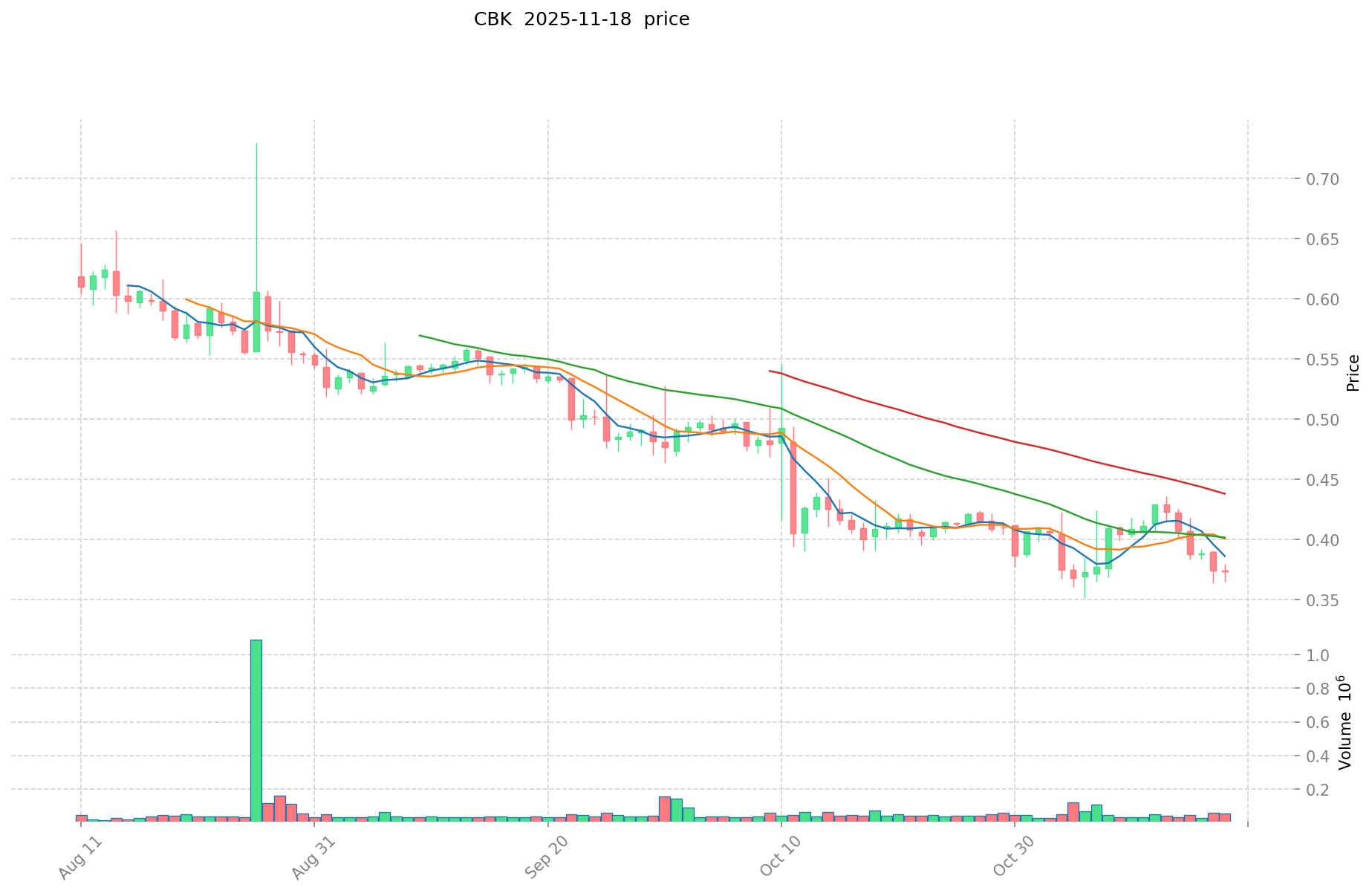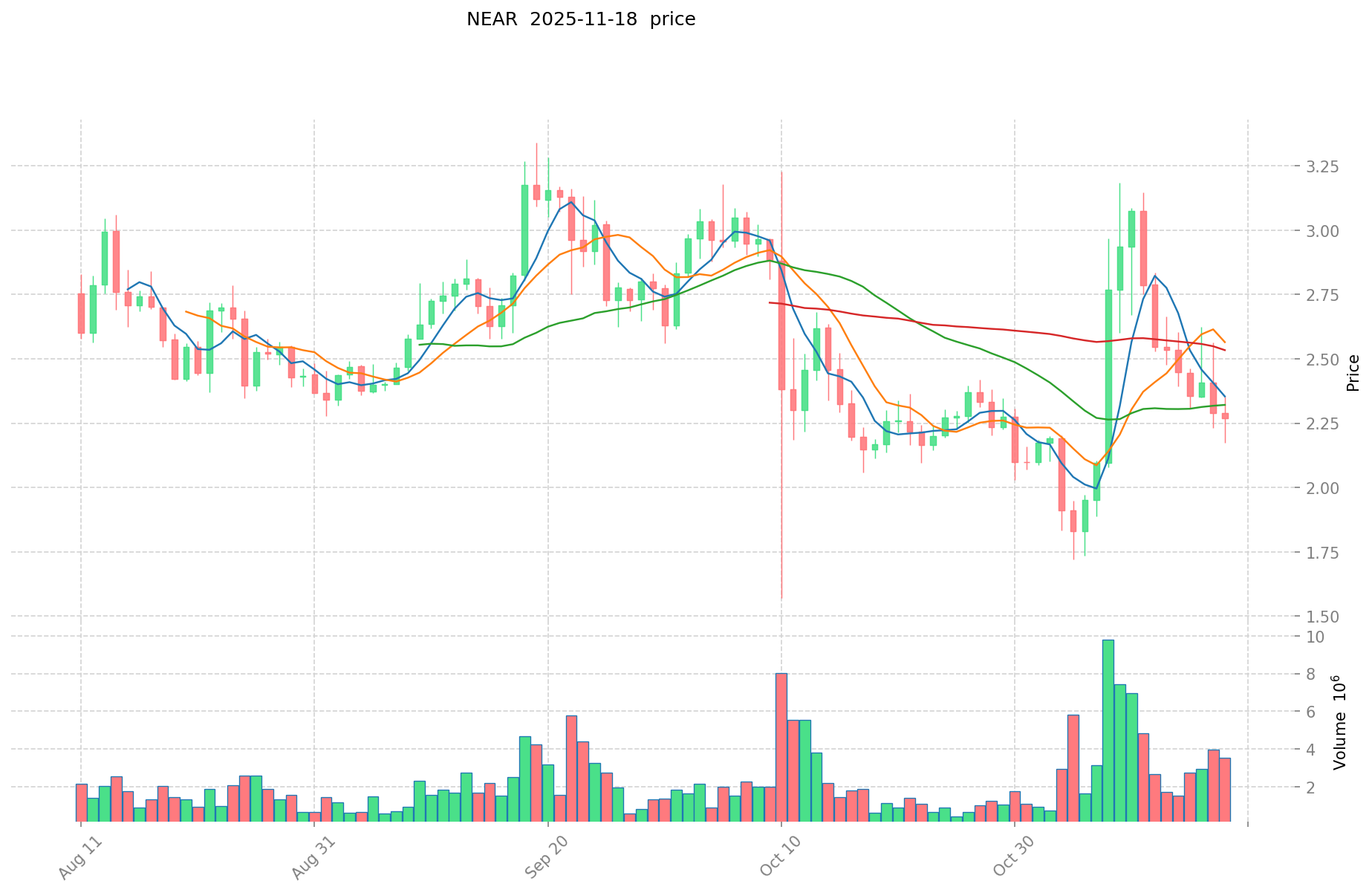CBK vs NEAR: A Comparative Analysis of Two Emerging Blockchain Platforms
Introduction: CBK vs NEAR Investment Comparison
In the cryptocurrency market, the comparison between Cobak (CBK) vs Near (NEAR) has always been an unavoidable topic for investors. The two not only have significant differences in market cap ranking, application scenarios, and price performance, but also represent different positioning in crypto assets.
Cobak (CBK): Since its launch, it has gained market recognition for its role as a community platform specializing in cryptocurrency.
NEAR (NEAR): Since its inception, it has been hailed as a highly scalable base protocol for supporting DApp operations on mobile devices, and is one of the cryptocurrencies with high global trading volume and market capitalization.
This article will comprehensively analyze the investment value comparison between CBK and NEAR, focusing on historical price trends, supply mechanisms, institutional adoption, technological ecosystems, and future predictions, attempting to answer the question investors care about most:
"Which is the better buy right now?"
I. Price History Comparison and Current Market Status
CBK and NEAR Historical Price Trends
- 2021: CBK reached its all-time high of $15.74 on April 2, 2021.
- 2022: NEAR achieved its all-time high of $20.44 on January 16, 2022.
- Comparative analysis: During the recent market cycle, CBK dropped from its high of $15.74 to a low of $0.354051, while NEAR declined from $20.44 to its current price of $2.258.
Current Market Situation (2025-11-18)
- CBK current price: $0.3707
- NEAR current price: $2.258
- 24-hour trading volume: CBK $14,873.01 vs NEAR $8,334,275.27
- Market Sentiment Index (Fear & Greed Index): 11 (Extreme Fear)
Click to view real-time prices:
- View CBK current price Market Price
- View NEAR current price Market Price


Investment Value Core Factors: CBK vs NEAR
Supply Mechanism Comparison (Tokenomics)
- CBK: Limited information available on specific supply mechanisms
- NEAR: Protocol uses a dynamic inflation model to incentivize participation while maintaining economic stability
- 📌 Historical Pattern: Supply mechanisms drive market cycles through predictable scarcity and inflation control.
Institutional Adoption and Market Applications
- Institutional Holdings: Limited data on institutional preference between these assets
- Enterprise Applications: Both tokens demonstrate potential in blockchain financing applications, with value derived from underlying technological infrastructure
- Regulatory Stance: Compliance with financial regulations remains a critical factor for both assets' long-term viability
Technological Development and Ecosystem Building
- CBK Technical Features: Focus on trust mechanisms and transparent operations
- NEAR Technical Development: Prioritizes system upgrades while maintaining core principles of fund protection and operational transparency
- Ecosystem Comparison: Both emphasize innovation-driven efficiency and trust-based longevity in their respective ecosystems
Macroeconomic Factors and Market Cycles
- Inflation Performance: Conservative monetary policies focused on controlling inflation may impact both assets
- Monetary Policy Impact: Central bank policies regarding digital assets could significantly influence adoption rates
- Geopolitical Factors: Cross-border transaction capabilities may provide competitive advantages in international markets
III. 2025-2030 Price Prediction: CBK vs NEAR
Short-term Prediction (2025)
- CBK: Conservative $0.19292 - $0.371 | Optimistic $0.371 - $0.44891
- NEAR: Conservative $2.17765 - $2.245 | Optimistic $2.245 - $2.80625
Mid-term Prediction (2027)
- CBK may enter a growth phase, with estimated prices ranging from $0.26755713075 to $0.60552403275
- NEAR may enter a bullish phase, with estimated prices ranging from $2.890830375 to $3.784901625
- Key drivers: Institutional fund inflows, ETF, ecosystem development
Long-term Prediction (2030)
- CBK: Base scenario $0.53884064818307 - $0.626558893236128 | Optimistic scenario $0.626558893236128 - $0.670418015762657
- NEAR: Base scenario $3.731982233167125 - $4.442835991865625 | Optimistic scenario $4.442835991865625 - $4.576121071621593
Disclaimer
CBK:
| 年份 | 预测最高价 | 预测平均价格 | 预测最低价 | 涨跌幅 |
|---|---|---|---|---|
| 2025 | 0.44891 | 0.371 | 0.19292 | 0 |
| 2026 | 0.52884195 | 0.409955 | 0.27466985 | 10 |
| 2027 | 0.60552403275 | 0.469398475 | 0.26755713075 | 26 |
| 2028 | 0.65032811718875 | 0.537461253875 | 0.49983896610375 | 44 |
| 2029 | 0.659223100940381 | 0.593894685531875 | 0.451359961004225 | 60 |
| 2030 | 0.670418015762657 | 0.626558893236128 | 0.53884064818307 | 69 |
NEAR:
| 年份 | 预测最高价 | 预测平均价格 | 预测最低价 | 涨跌幅 |
|---|---|---|---|---|
| 2025 | 2.80625 | 2.245 | 2.17765 | 0 |
| 2026 | 3.43485 | 2.525625 | 2.0205 | 11 |
| 2027 | 3.784901625 | 2.9802375 | 2.890830375 | 32 |
| 2028 | 4.769423083125 | 3.3825695625 | 2.0295417375 | 49 |
| 2029 | 4.80967566091875 | 4.0759963228125 | 3.546116800846875 | 80 |
| 2030 | 4.576121071621593 | 4.442835991865625 | 3.731982233167125 | 96 |
IV. Investment Strategy Comparison: CBK vs NEAR
Long-term vs Short-term Investment Strategy
- CBK: Suitable for investors focused on community-driven platforms and niche market potential
- NEAR: Suitable for investors seeking scalable infrastructure and broader ecosystem growth
Risk Management and Asset Allocation
- Conservative investors: CBK: 20% vs NEAR: 80%
- Aggressive investors: CBK: 40% vs NEAR: 60%
- Hedging tools: Stablecoin allocation, options, cross-currency portfolios
V. Potential Risk Comparison
Market Risk
- CBK: Higher volatility due to smaller market cap and lower liquidity
- NEAR: Susceptible to broader crypto market trends and competition from other layer-1 protocols
Technical Risk
- CBK: Platform scalability, network stability
- NEAR: Smart contract vulnerabilities, potential blockchain congestion
Regulatory Risk
- Global regulatory policies may have differing impacts on both assets, with NEAR potentially facing more scrutiny due to its larger scale and wider adoption
VI. Conclusion: Which Is the Better Buy?
📌 Investment Value Summary:
- CBK advantages: Specialized community platform, potential for rapid growth in niche market
- NEAR advantages: Established ecosystem, higher liquidity, focus on scalability and mobile DApp support
✅ Investment Advice:
- Novice investors: Consider a higher allocation to NEAR due to its more established market position and ecosystem
- Experienced investors: Balanced approach with both assets, leveraging CBK's growth potential and NEAR's stability
- Institutional investors: Focus on NEAR for its liquidity and ecosystem development, with a smaller allocation to CBK for diversification
⚠️ Risk Warning: The cryptocurrency market is highly volatile. This article does not constitute investment advice. None
VII. FAQ
Q1: What are the main differences between CBK and NEAR? A: CBK is a community platform specializing in cryptocurrency, while NEAR is a highly scalable base protocol for supporting DApp operations on mobile devices. NEAR has a higher market cap, trading volume, and more established ecosystem compared to CBK.
Q2: Which cryptocurrency has performed better historically? A: NEAR has shown better historical performance. It reached its all-time high of $20.44 on January 16, 2022, while CBK's all-time high was $15.74 on April 2, 2021. Currently, NEAR is trading at $2.258, while CBK is at $0.3707.
Q3: What are the price predictions for CBK and NEAR by 2030? A: By 2030, CBK is predicted to reach between $0.53884064818307 and $0.670418015762657 in the base and optimistic scenarios. NEAR is expected to reach between $3.731982233167125 and $4.576121071621593 in the base and optimistic scenarios.
Q4: How do the supply mechanisms of CBK and NEAR differ? A: Limited information is available on CBK's specific supply mechanisms. NEAR uses a dynamic inflation model to incentivize participation while maintaining economic stability.
Q5: What are the main risks associated with investing in CBK and NEAR? A: CBK faces higher volatility due to its smaller market cap and lower liquidity, while NEAR is more susceptible to broader crypto market trends and competition from other layer-1 protocols. Both face potential regulatory risks, with NEAR potentially facing more scrutiny due to its larger scale and wider adoption.
Q6: How should different types of investors approach CBK and NEAR? A: Novice investors may consider a higher allocation to NEAR due to its more established market position. Experienced investors could take a balanced approach with both assets. Institutional investors might focus on NEAR for its liquidity and ecosystem development, with a smaller allocation to CBK for diversification.
Q7: What are the technological focuses of CBK and NEAR? A: CBK focuses on trust mechanisms and transparent operations, while NEAR prioritizes system upgrades while maintaining core principles of fund protection and operational transparency. Both emphasize innovation-driven efficiency and trust-based longevity in their respective ecosystems.
Share
Content